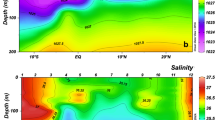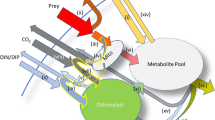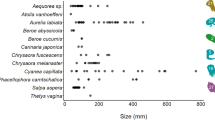Abstract
Growth and herbivory of heterotrophic dinoflagellates (Gymnodinium sp.) from the Weddell Sea and the Weddell/Scotia Confluence were studied in 1988 in 100-liter microcosms. The microcosms were screened through 200-µm or 20-µm mesh nets and incubated for 12 d at 1 °C under artificial light. Mean cell volume of dinoflagellates was 1 000 to 1 500µm3, and that of their phytoplankton prey 360 to 430µm3. Dinoflagellate growth rate followed a Holling type II functional response, with a maximum growth rate of 0.3 d−1 and half-saturation food concentrations of 1.0µg chlorophylla l−1, 50µg C l−1, or 1 500 cells ml−1. Carbon budgets based on14CO2 assimilation and biomasses of phytoplankton and heterotrophic dinoflagellates suggested a balance between phytoplankton grazing loss and dinoflagellate consumption, assuming a dinoflagellate carbon conversion efficiency of 40%. Applying this to the functional response yielded estimates of maximum ingestion rate (0.8µg Cµg−1 C d−1, or 6 pg C dinoflagellate−1 h−1) and maximum clearance (0.8 to 1.2 × 105 body volumes h−1, or 80 to 120 nl ind.−1 h−1). The microcosm experiments suggested that heterotrophic dinoflagellates may contribute significantly to maintenance of low phytoplankton biomass in the Southern Ocean.
Similar content being viewed by others
Literature cited
Andersen, P. (1989). Functional biology of the choanoflagellate Diaphanoeca grandis Ellis. Mar. microb. Fd Webs 3: 35–50
Azam, F., Fenchel, T., Field, J. G., Gray, J. S., Meyer-Reil, L. A., Thingstad, F. (1983). The ecological role of water-column microbes in the sea. Mar. Ecol. Prog. Ser. 10: 257–263
Baar, H. J. W. de, Buma, A. G. J., Nolting, R. F., Cadee, G. C., Jaques, G., Treguer, P. (1990). On iron limitation of the Southern Ocean: experimental observations in the Weddell and Scotia Seas. Mar. Ecol. Prog. Ser. 65: 105–122
Bjørnsen, P. K., Kuparinen, J. (1991). Determination of bacterioplankton biomass, net production and growth efficiency in the Southern Ocean. Mar. Ecol. Prog. Ser. 71: 185–194
Børsheim, K. Y., Bratbak, G. (1987). Cell volume to cell carbon conversion factors for a bacteriovorousMonas sp. enriched from seawater. Mar. Ecol. Prog. Ser. 36: 171–175
Caron, D. A., Goldman, J. C., Dennett, M. R. (1986). Effect of temperature on growth, respiration, and nutrient regeneration by an omnivorous microflagellate. Appl. envirl Microbiol. 52: 1340–1347
Choi, J. W., Stoecker, D. K. (1989). Effects of fixation on cell volume of marine planktonic protozoa. Appl. envirl. Microbiol. 55: 1761–1765
Edler, L. (1979). Recommendations for marine biological studies in the Baltic Sea: phytoplankton and chlorophyll. Publs Baltic mar. Biologists 5: 1–38
Fenchel, T. (1982). Ecology of heterotrophic flagellates. II. Bioenergetics and growth. Mar. Ecol. Prog. Ser. 8: 225–231
Fenchel, T. (1986). The ecology of heterotrophic flagellates. Adv. microb. Ecol. 9: 57–95
Fenchel, T. (1987). Ecology — potentials and limitations. In: Kinne, O. (ed.) Excellence in ecology 1. Ecology Institute, Oldendorf/Luhe, Germany
Gaines, G., Elbrächter, M. (1987): Heterotrophic nutrition. In: Taylor, F. J. R. (ed.) The biology of dinoflagellates. Blackwell, Oxford, p. 224–268
Gaines, G., Taylor, F. J. R. (1984). Extracellular digestion in marine dinoflagellates. J. Plankton Res. 6: 1057–1061
Garrison, D. L., Gowing, M. M., Buck, K. R., Coale, S. L., Thomsen, H. A. (1986). Microheterotrophs in the ice edge zone: an AMERIEZ study. Antarctic J. U.S. 21: 169–170
Goldman, J.C., Dennett, M. R., Gordin, H. (1989). Dynamics of herbivorous grazing by the heterotrophic dinoflagellateOxyrrhis marina. J. Plankton Res. 11: 391–407
Haas, L. W. (1982). Improved epifluoresence microscopy for observing planktonic microorganisms. Ann. Inst. Oceanogr. 58: 261–266
Heinbokel, J. F. (1978). Studies of the functional role of tintinnids in the Southern California Bight. I. Grazing and growth rates in laboratory cultures. Mar. Biol. 47: 177–189
Hewes, C. D., Holm-Hansen, O., Sakshaug, E. (1985). Alternate carbon pathways at lower trophic levels in the Antarctic food web: In: Siegfried, W. R., Condy, P. R., Laws, R. M. (eds.) Antarctic nutrient cycles and food webs. Springer, Berlin, p. 277–283
Jacobson, D. J. (1988). Growth and feeding rates ofProtoperidinium. In: Burkill, P. H., Reid, P. C. (eds.) NATO/ASI Protozoa and their role in marine processes. Workshop abstract. Plymouth Marine Laborataory, Plymouth, U.K.
Jacobsen, D. J., Anderson, D. M. (1986). Thecate heterotrophic dinoflagellates: feeding behaviour and mechanisms. J. Phycol. 22: 249–258
Jonsson, P. R. (1986). Particle size selection, feeding rates and growth dynamics of marine planktonic oligotrichous ciliates (Chiophora: Oligotrichina). Mar. Ecol. Prog. Ser. 33: 265–277
Lessard, E. J. (1991). The trophic role of heterotrophic dinoflagellates in diverse marine environments. Mar. microb. Fd Webs 5
Lessard, E. J., Swift, E. (1985). Species-specific grazing rates of hetertrophic dinoflagellates in oceanic waters, measured with a dual-label radio-isotope technique. Mar. Biol. 87: 289–296
Lorenzen, C. J. (1967). Determination of chlorophyll and phaeopigments: spectrophotometric equations. Limnol. Oceanogr. 12: 343–346
Martin, J. H., Fitzwater, S. E. (1988). Iron deficiency limits phytoplankton growth in the Northeast Pacific subarctic. Nature, Lond. 331: 341–343
Nelson, D. M., Smith, W. O., Muench, R. D., Gordon, L. I., Sullivan, C. W., Husby, D. M. (1989). Particulate matter and nutrient distribution in the ice-edge zone of the Weddell Sea: relationship to hydrography during late summer. Deep-Sea Res. 36: 191–209
Nöthig, E.-M., Bodungen, B. von (1989). Occurrence and vertical flux of faecal pellets of probable protozoan origin in the Southeastern Weddell Sea (Antarctica). Mar. Ecol. Prog. Ser. 56: 281–289
Peterson, B. J. (1980). Aquatic primary productivity and the14CO2-method. A. Rev. Ecol. Syst. 11: 359–385
Putt, M., Rivkin, R. B., Prézelin, B. B. (1988). Effect of altered photic regimes on diel patterns of species-specific photosynthesis. Mar. Biol. 97: 435–443
Putt, M., Stoecker, D. K. (1989). An experimentally determined carbon:volume ratio for marine “oligotrichous” ciliates from estuarine and coastal areas. Limnol. Oceanogr. 34: 1097–1103
Shapiro, L. P., Haugen, E. M., Carpenter, E. J. (1989). Occurrence and abundance of green-fluorescing dinoflagellates in surface waters of the Northwest Atlantic and Northeast Pacific oceans. J. Phycol. 25: 189–191
Sheldon, R. W., Prakash, A., Sutcliffe, W. H. (1972). The size distribution of particles in the ocean. Limnol. Oceanogr. 17: 327–340
Sheldon, R. W., Rassoulzadegan, F. (1987). A method for measuring plankton production by particle counting. Mar. microb. Fd Webs 2: 29–44
Sherr, B. F., Sherr, E. B., Berman, T. (1983). Grazing, growth and ammonia excretion of a heterotrophic microflagellate fed with four species of bacteria. Appl. envirl Microbiol. 45: 1196–1204
Sherr, B. F., Sherr, E. B., Rassoulzadegan, F. (1988). Rates of digestion of bacteria by marine phagotrophic protozoa: temperature dependence. Appl. envirl Microbiol. 54: 1091–1095
Smetacek, V. (1981). The annual cycle of protozooplankton in the Kiel Bight. Mar. Biol. 63: 1–11
Smith, W. O. (1987). Phytoplankton dynamics in marginal ice zones. Oceanogr. mar. Biol. A. Rev. 25: 11–38
Smith, W. O., Nelson, D. M. (1985). Phytoplankton bloom produced by a receding ice edge in the Ross Sea: spatial coherence with the density field. Science, N.Y. 227: 163–166
Spies, A. (1987). Growth rates of Antarctic marine phytoplankton in the Weddell Sea. Mar. Ecol. Prog. Ser. 41: 267–274
Strathman, R. R. (1967). Estimating the organic carbon content of phytoplankton from cell volume or plasma volume. Limnol. Oceanogr. 12: 411–418
Tilzer, M. M., Bodungen, B. von, Smetacek, V. (1985). Light-dependence of phytoplankton photosynthesis in the Antarctic Ocean: implications for regulating productivity. In: Siegfried, W. R., Condy, P. R., Laws, R. M. (eds.) Antarctic nutrient cycles and food webs. Springer, Berlin, p. 277–283
Verity, P. G. (1985). Grazing, respiration, excretion, and growth rates of tintinnids. Limnol. Oceanogr. 30: 1268–1282
Author information
Authors and Affiliations
Additional information
Communicated by T. Fenchel, Helsingør
Rights and permissions
About this article
Cite this article
Bjørnsen, P.K., Kuparinen, J. Growth and herbivory by heterotrophic dinoflagellates in the Southern Ocean, studied by microcosm experiments. Mar. Biol. 109, 397–405 (1991). https://doi.org/10.1007/BF01313505
Accepted:
Issue Date:
DOI: https://doi.org/10.1007/BF01313505




